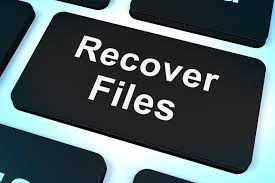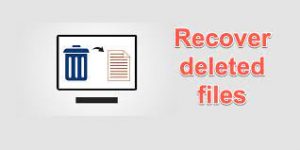
It happens all the time. You decide to clean up your hard drive and then three days later you can’t find an important file. It’s not in the right folder or the Recycle Bin, and you don’t have a hard drive back-up. You’ve accidentally deleted the file. So now what?
Take a deep breath, unclench your jaw, and relax your shoulders. Whether it’s an Excel, Word, PowerPoint, Outlook email, or any other kind of file, with our help it’s possible that you can recover accidentally deleted files in Windows.
Increase Your Odds of Recovering Deleted Files
When a file gets deleted, it doesn’t disappear. The data stays there until another file overwrites it. There are a few things to do as soon as you realize the file was accidentally deleted to increase the odds of recovering it.
- Don’t make, copy, move, delete, or edit any more files.
- Exit all programs, including any programs running in the system tray. To exit programs in the system tray, right-click and select Exit, Quit, or Close if the option exists. Even if you’re not actively using a program, it’s still reading and writing data.
- Have another drive to which the file will be recovered. A USB flash drive will do. Trying to recover a file to the same drive it was deleted from reduces the odds of successful recovery.
Is the File Really Deleted?
Ask any IT professional and they’ll have at least one experience where a person thought a file was deleted, but it was accidentally placed in a different folder.
Use Built-In Microsoft Tools to Recover Deleted Files
There are several tools and methods already in Windows and Office to help recover deleted files.
Recover a Deleted File by Restoring Microsoft OneDrive
If you’re not using OneDrive or some sort of cloud backup, please set that up now. There are several free cloud storage services available.
If the file was deleted in the last 30 days for personal OneDrive accounts, or the last 93 days for work or school accounts, recover it from the OneDrive Recycle Bin. For work or school accounts, you may need someone from the IT Department to restore your OneDrive.
If the OneDrive Recycle bin was emptied, it may be possible to restore the entire OneDrive to a point in time when the file existed and can be restored. Keep in mind, this restores the whole OneDrive. So all your files will be restored back to that previous point in time. Any changes or files saved after that point in time will be lost.
- Log in to OneDrive in a web browser and;
- Select the gear icon.
- Select Options.
- On the new page:
- Select Restore your OneDrive.
- Select Verify your identity.
- A new window will open showing the verification method set by you when setting up OneDrive. In this example, it’s a recovery email address. The recovered email address will be obscured with some asterisks. Select the Email option.
- OneDrive will then require you to;
- Enter the complete recovery email address.
- Select Send code. If it’s the correct recovery email address, a code will be sent to it.
- Check your email for the verification code and:
- Enter it in the new Enter code window.
- Select Verify.
- If the code is correct, the Restore your OneDrive page loads.
- Choose the Select a date dropdown box.
- Select how far back to go with the OneDrive restore.
- The Restore Your OneDrive page reloads with the option to be more specific. Choose either to:
- Move the slider to a previous day based on the activity level on that day.
- Select a specific change event. If the 4th specific event was chosen, then events 1, 2, and 3 are included in the restoration.
Then select Restore to start the process.
- To confirm “…you want to restore your OneDrive…”, select Restore.
- OneDrive will begin restoring to the point chosen. How long the restoration takes depends on the size of the OneDrive. Once the restoration is complete, select Return to your OneDrive to go see the accidentally deleted file or folder.
Best Deleted File Recovery Apps
If none of the methods above worked for you, there are several apps that will help. Most data recovery apps have a free option that limits the total size of files recovered, but it will likely be enough for most people. We’ll share with you some of our favorite file recovery apps and how well they worked for us in Windows.
To test them, we deleted a set of files including a Word, Excel, and Notepad file using Shift + Del. Then we tried to recover them with the file recovery apps. Our results may not be proof of how it will work for you. The apps may work better or not as well. There are many factors that can affect their performance.
Create an Image of the Drive First
The apps we’re reviewing take a deep dive into the hard drive and its file system. It can be easy to overwrite the deleted file you need while looking for it. Then it’s really gone. Use one of the best free hard drive cloning apps to create an image or clone of the hard drive first. Also check out our guide to backups, system images, and recovery for Windows.
Ideally, you’ll already have one or more of these apps installed or saved on a USB flash drive before needing to recover files. Installing new programs could overwrite the remaining data of the deleted file.
Recuva
You’re likely familiar with Recuva’s sibling CCleaner. Like CCleaner, Recuva has free and paid versions. It’s also the easiest app to use among the file recovery apps we tested. There’s also a portable Recuva option that can be run from a USB flash drive, so Recuva doesn’t need to be installed on your PC.
The free version will work for most situations. It supports recovering most file types and most media such as memory cards, USB flash drives, and external drives. The professional version also supports file recovery with virtual hard drives and comes with automatic updates and support. Pretty good for about $20. If you feel that Recuva isn’t quite thorough enough, take a look at Disk Drill.
Recuva Test
Recuva has a wizard that will step you through the recovery process. Even though it allows you to focus the scan on the folder the files were last in, Recuva will scan the entire drive.
Recuva did identify the deleted test files and thousands more. Notice the red dot next to the Test Notepad File.txt. That’s Recuva telling us it’s not likely to recover it. Recuva was able to restore the test Word and Excel files, but not the Notepad file.
Disk Drill
Even the free version of Disk Drill is unbelievably thorough at showing deleted files on a hard drive. Disk Drill previews files before recovering them and works on any type of storage media such as hard drives, solid-state drives (SSD), USB drives, and SD cards.
Disk Drill can also recover pretty much any file type. Plus, it’s available for Windows and Mac. The free version has limitations, of course.
Disk Drill Test
Using the Quick Scan option on a 1 TB drive, Disk Drill finished in seconds and was thorough. It did recover the deleted documents completely in one try, as well as restore them with their directory structure intact.
Be aware that Disk Drill might lock the drive you’re recovering files from so that it becomes read-only. It does that to protect all the other deleted files in case you want to recover more. DiskDrill will make the drive writable again when the session ends.
TestDisk
It’s not just for Windows. TestDisk has versions for Linux, macOS, and legacy Microsoft systems like Windows 98, 95, and even MS-DOS. TestDisk is free and comes bundled with PhotoRec; a photo recovery app. Both TestDisk and PhotoRec are portable applications, so they can be run from a USB drive. It’s well respected in the IT world, as shown by its inclusion in almost every LiveCD including Hiren’s BootCD, Parted Magic, and Ultimate Boot CD.
The downside for the average person is that TestDisk is used in the command line. There is a bit of a learning curve and it’s possible to accidentally do more damage if a mistake is made. If you’d prefer something with a graphical user interface, TestDisk also recommends DiskDrill.
TestDisk Test
Although TestDisk is run from the command line, it was easier to use than we thought. There’s good documentation on how to recover files with TestDisk on their site. TestDisk seemed to list every file ever deleted from the drive, and we had to scroll through them for a long time to find the test files. It was scary how in-depth the scan was. Names of files deleted in 2011 were shown.
Once the test files were found, TestDisk recovered them completely and quickly, maintaining their directory structure. It’s powerful, but not for people in a hurry.
If this tip helps and you would like to donate click on the button. Thanks In Advance.
________________________________________________________________________________________________________
"Fortune Favors, Who Value Time over Money!"
"TeQ I.Q. was the 1st IT Company to Deliver Cloud Solutions since 2003"
Tech issues taking up your Time?
"TeQ I.Q. Makes Your Technology Secure and Protected"
Do you have Tech Frustrations like your Computer, Internet, Phone, Cellphone, Camera, TV, Car?
"Afraid of Online Hacking?"
"SECURE your Internet and Devices with before it's too late!"
For more info go to https://www.teqiq.com/vpn/
"We Take Away Your Tech Frustrations and Give You the Free Time You Deserve!"
Call Robert to ask all your Technology questions.
For Free Consultation Call Now Robert Black at (619) 255-4180 or visit our website https://www.teqiq.com/
Chase Bank and Others Trust TeQ I.Q. with their IT and TeQnology so can you!




